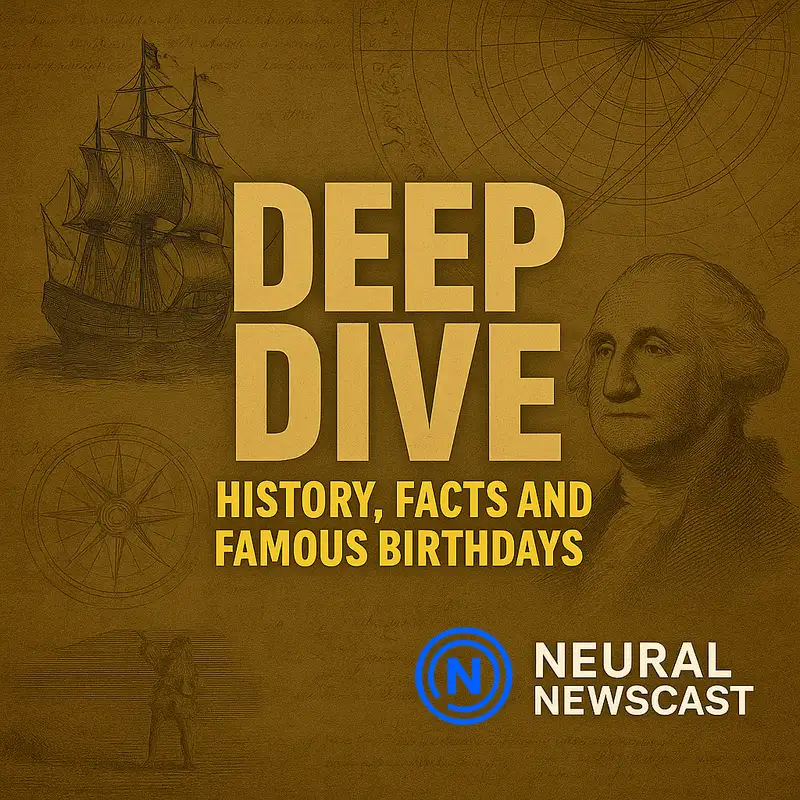Deep Dive: Pioneering Paths and Starry Celebrations: A May 22nd Deep Dive - May 22, 2025
This is NNC, Neural Newscast.
Get ready for a deep dive from Neural Newscast.
I'm Daniel, and Sarah is here with me as we delve into today's subjects.
Today, we're diving into a pivotal moment in American history from 1843.
It's the day the first major wagon train left Elm Grove, Missouri, marking the beginning
of the Oregon Trail as a vital conduit to the west.
Quite an adventurous leap into the unknown, don't you think, Sarah?
Absolutely, Daniel. It's fascinating how this single event sparked a massive wave of migration.
Imagine the courage it took for families to pack everything they owned into a wagon and
head into such uncertain territory.
What's remarkable is how they faced not just the promise of opportunity but also significant
risks. We're talking about a 2,000 mile journey that could stretch over 4 to 6 months.
That's longer than most of our vacations, combined.
Exactly. And let's not forget, they had no GPS or weather apps,
just the sky, some maps, and a whole lot of hope to guide them.
The Oregon Trail was all about the promise of prosperity land, resources, and a fresh start.
Those were big selling points back then.
Indeed, and the challenges were just as big.
They dealt with harsh weather, rugged terrain, and limited supplies.
I read that even crossing rivers posed huge hurdles.
Some say the Platte River alone swallowed a few wagons whole.
Oh, the platte. I heard it was called a mile wide and an inch deep, notorious for its deceptive nature.
But it wasn't just the rivers. Disease was rampant, with cholera being a notorious killer on those trails.
A staggering reminder of how perilous the journey was.
Yet, despite these hardships, the Oregon Trail became a symbol of American perseverance and ambition.
Over 400,000 settlers had traveled it by the time migration peaked.
That's like moving a city.
And what's interesting, Daniel, is how the trail itself evolved into a cultural touchstone.
Artists, writers, everyone romanticized the westward expansion, painting it as this grand adventure in the face of adversity.
Even today, we see echoes of that spirit in our pop culture and national identity.
It's hard not to be inspired by the sheer grit and determination of those pioneers.
Exactly, it's a reminder of how far determination can take you, even if it's on a rickety
wagon over daunting landscapes.
Sometimes I wonder how many would take such risks today if faced with similar circumstances.
Good question.
It makes you appreciate the resolve of those who blazed the trail.
Their legacy?
It's the foundation of the cities, economies, and diverse cultures that we see across the
American West today.
And thinking about that start in Elm Grove, Missouri, it's incredible how one small beginning
could ripple out so far.
Just goes to show, big things often have small beginnings, right?
Absolutely, Sarah.
It's a testament to the power of human ambition and the indomitable quest for a better life,
shaping history along the way.
Today we celebrate the birthdays of James Joyce 1882, Rosa Parks, 1913, and Alice Cooper, 1948.
And what a lineup that is, Daniel. I think we absolutely have to dive deeper into Rosa Parks' story today.
Absolutely, Sarah.
Rosa Parks, known as the mother of the civil rights movement, made an indelible mark on American history with one brave act of defiance.
Right, it was December 1, 1955, when she refused to give up her bus seat to a white passenger
in Montgomery, Alabama.
That single act sparked the Montgomery bus boycott.
It's fascinating how such a moment of personal resolve became a catalyst for nationwide
change.
The boycott lasted over a year and eventually led to the Supreme Court ruling that segregation
on public buses was unconstitutional.
Exactly, and it wasn't just about buses.
Her courage embodied a larger fight against racial inequality and injustice.
Parks became an international icon of resistance to racial segregation.
And her impact extended far beyond that single moment.
After the boycott, she continued to work with leading civil rights leaders, like Dr. Martin Luther King, Jr.
Not to mention, she also worked for Congressman John Conyers for over two decades, championing
civil rights legislation and outreach.
Here's a lesser-known fact.
Rosa Parks wasn't the first person to resist bus segregation, but her case was chosen strategically
by the NAACP to challenge the law.
They understood the power of her quiet dignity.
That's a great point, Daniel.
Her image and story resonated powerfully, helping galvanize a movement that was already
percolating under the surface.
And what's remarkable is how her legacy continues to inspire new generations.
The courage she showed in that moment is a timeless lesson in standing up for what's right.
Absolutely, Daniel. Her story serves as a reminder that seemingly small acts of resistance can ripple out and inspire monumental change.
And that's the lasting legacy of Rosa Parks. Her quiet strength became a loud, enduring call for justice and equality.
We'll be right back after this short break.
Stay tuned to NNC for unbiased daily news summaries.
Subscribe and explore our archives at NNewscast.com.
This is Neural Newscast.
Welcome back to Neural Newscast deep dive.
Let's continue our exploration.
Did you know there's a place on Earth where you can stand in four different states at once?
Oh, you're talking about the Four Corners Monument, right?
It's where Arizona, New Mexico, Utah, and Colorado all meet.
It's such an intriguing spot. I mean, not only can you technically be in four states simultaneously,
but it's also rich with history and cultural significance.
The fact that it's the only point in the United States where four state boundaries intersect,
it almost feels like a natural crossroad or a meeting place.
It makes you think about how state lines were drawn in the first place.
Indeed, the lines we have today are the results of some fascinating historical negotiations and geographical considerations.
The Four Corners is a perfect example of that blend of natural geography and human decision.
And it's more than just lines on a map.
The area is steeped in Native American history, isn't it?
The Navajo Nation and the Yut Mountain Yut tribe have lands bordering the monument.
Absolutely. The region is a cultural mosaic.
I think people often overlook how much more there is to the site than the sheer novelty of standing in four states at once.
It's a reminder of the deep historical roots in that area.
And, naturally, it has become quite the tourist attraction.
Thank you.
I read that millions of people visit each year just to have that unique experience of standing on the marker.
Yes, and it's interesting to see how people react to it.
Some take photos while stretching across state lines, others do Hansons.
It's like a playful act of being in multiple places at once.
Exactly. It's a blend of fun and history.
Plus, the landscape itself is pretty stunning.
Those vast open spaces are quite reflective of the American Southwest.
I agree.
The scenery is breathtaking, particularly with those expansive desert vistas and the clear,
open skies.
It gives you a sense of the vastness of the area.
And speaking of vastness, when you think about the intricacies of state borders,
it's fascinating how they can be both arbitrary and deeply meaningful.
Little markers like this one connect people to specific locations in unexpected ways.
That's so true. It's like a physical manifestation of how we organize our space and a reminder of the stories behind those decisions.
It's a geographical enigma, right?
The four corners might seem simple on the surface, but it reflects a complex web of history,
culture, and natural beauty.
Exactly.
It's one of those places where you can feel the weight of history and the lightness of
a fun photo op all in one go.
A perfect blend of past and present.
That's all for this Neural Newscast deep dive.
On behalf of Daniel and myself, Sarah, thanks for listening.
You've been listening to Neural Newscast, where history and curiosity collide.
Dive deeper at NNewscast.com.
At Neural Newscast, we mix real voices with AI-generated ones to bring you fast, high-quality news.
Every story is created with AI but reviewed by humans to keep things accurate and fair.
While we do our best to prevent mistakes, AI isn't perfect.
So double-check key facts with trusted sources.
Want to know more about our AI process?
Head to endnewscast.com.

